Lighting
Can LED Lighting Harm You?
Uncover the hidden dangers of LED lighting on your health, from disrupting sleep to eye damage and more.
LED lighting can harm individuals by disrupting circadian rhythms, impacting sleep quality, and potentially causing eye damage. Blue light emitted by LEDs can interfere with melatonin production, leading to sleep disturbances and health issues. Mindful exposure, such as selecting warmer LED bulbs, can help mitigate these risks. Streetlights and vehicle lights can also pose glare problems if not properly diffused. Vulnerable groups like children or the elderly may be more sensitive to these effects. Understanding the impact of LED lighting on skin health, specifically UV exposure, is essential. Exploring the outlined topics further can provide a deeper understanding of LED lighting's potential harm.
Key Takeaways
- LED lighting can disrupt circadian rhythms and impact sleep patterns.
- Blue light from LEDs suppresses melatonin production, affecting sleep quality.
- Prolonged exposure to LED lights may lead to potential eye damage.
- Vulnerable groups, like children and the elderly, are at higher risk.
- Properly selecting LED bulbs and managing screen time can mitigate harm.
Potential Harm From LED Blue Light
LED blue light poses potential harm to individuals by disrupting circadian rhythms and impacting sleep patterns. The exposure to blue light, especially in the evening from LED sources, can result in poor sleep quality. Not only does this affect sleep patterns, but over time, it has also been linked to potential eye damage. Prolonged exposure to blue-rich light, commonly emitted by LED screens, is concerning as it may contribute to various mental and physical health conditions. Unlike natural sunlight, artificial blue light from LEDs lacks the compensatory radiation, raising further health concerns.
The impact of blue light on individuals goes beyond just disrupting sleep; it has far-reaching consequences on eye health, mental well-being, and physical health. As technology advances and LED lighting becomes more prevalent in daily life, understanding the potential risks associated with blue light exposure is essential for promoting overall health and well-being. It's important to be mindful of the sources of artificial light and take necessary precautions to mitigate the potential harmful effects of LED blue light exposure.
Effects on Circadian Rhythm
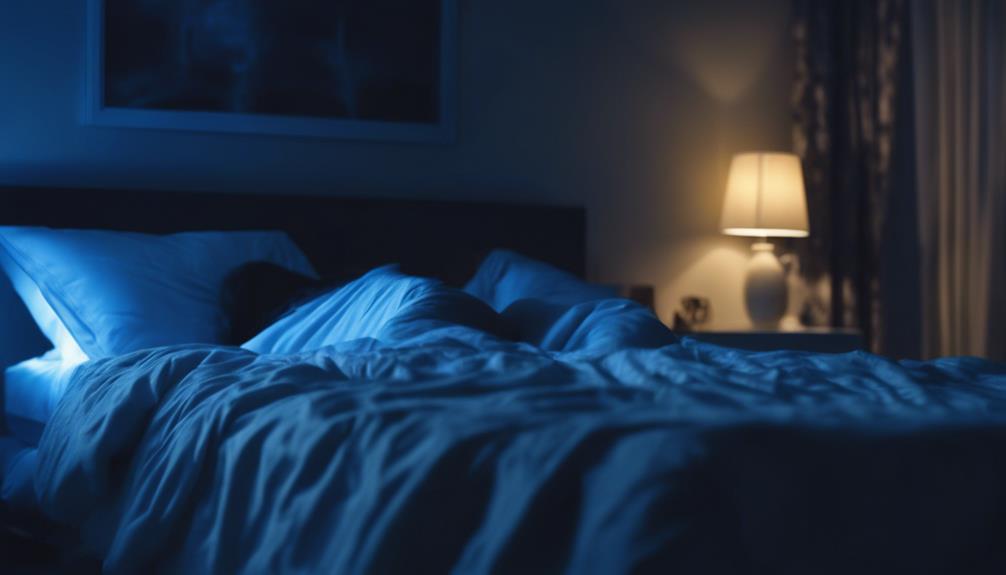
Exposure to blue light, particularly in the evening, can greatly disrupt the body's circadian rhythm, impacting essential functions such as sleep quality and overall health. LED lighting emitting blue light has the potential to suppress melatonin production, a hormone that regulates sleep-wake cycles. When exposed to blue light at night, especially from sources like LED lights, the brain may be tricked into perceiving it as daytime, thereby disrupting the natural circadian rhythm. This disruption can lead to difficulties falling asleep, causing insomnia and resulting in daytime fatigue.
Maintaining a healthy circadian rhythm is vital for overall well-being, and the excessive exposure to blue light from LED sources can throw this delicate balance off. To mitigate these effects, individuals should consider reducing blue light exposure, especially in the hours leading up to bedtime. Proper management of LED lighting usage, particularly by using warmer, less blue-enriched lights in the evening, can help support a more natural sleep-wake cycle and promote better sleep quality.
Sleep Disturbances and Health Issues
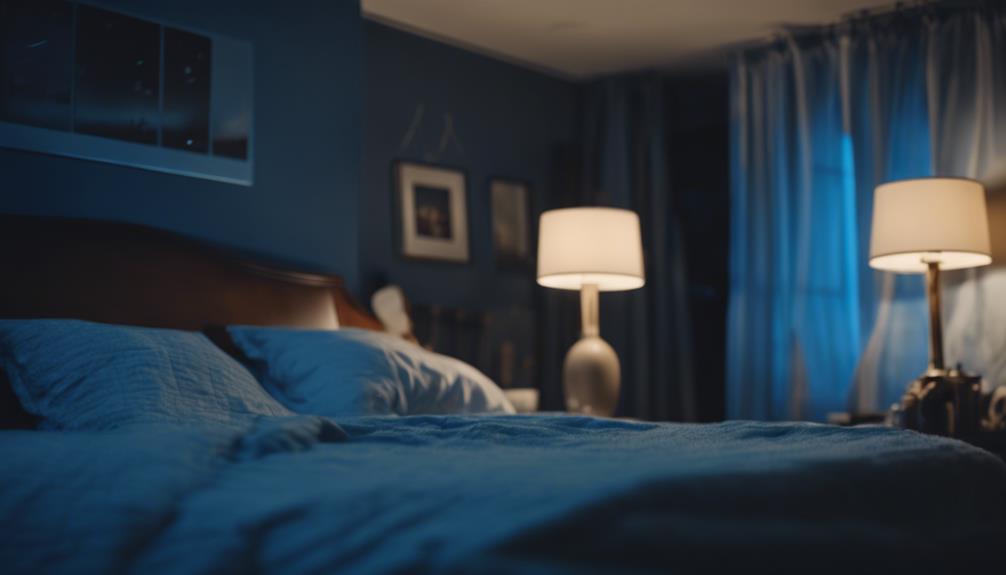
During nighttime exposure to blue light, individuals may experience disruptions in their sleep patterns, potentially leading to various health issues. Blue light emitted by LEDs can interfere with the body's production of melatonin, a hormone that regulates sleep-wake cycles. When exposed to artificial blue light, especially in the evening, melatonin production may be suppressed, making it harder to fall asleep and stay asleep. This disruption in circadian rhythms can't only result in sleep disturbances but also contribute to long-term health problems.
Consistent exposure to blue light from LED lighting can impact overall health by affecting the quality and quantity of sleep a person gets. Poor sleep quality has been linked to a range of health issues, including increased risk of obesity, heart disease, and mental health disorders. To minimize these risks, individuals can opt for LED bulbs with lower color temperatures and limit exposure to blue light in the hours leading up to bedtime. By being mindful of artificial light sources and their effects on sleep, individuals can better prioritize their health and well-being.
Lack of Compensatory Radiation

The absence of compensatory radiation in LED lighting disrupts the body's circadian rhythm. Unlike natural sunlight, LED lighting emits blue light that can interfere with melatonin production, leading to sleep disturbances. This disruption to the body's internal clock can have a significant impact on overall well-being.
The lack of a balanced spectrum of colors and energy levels in artificial blue light from LEDs further exacerbates these issues. Increased exposure to this type of light, especially in the evening, can negatively affect health. Prolonged use of LED devices like smartphones and tablets, which also emit blue light, contributes to these concerns.
It's essential to be mindful of the potential health implications associated with excessive exposure to artificial blue light from LED lighting sources. Protecting one's circadian rhythm and prioritizing healthy sleep habits can help mitigate the adverse effects of prolonged exposure to LED lighting.
Mindful Exposure to LED Lighting

Amid concerns about the potential health impacts of LED lighting, making mindful choices in selecting LED bulbs can greatly reduce blue light exposure and promote overall well-being.
Mindful exposure to LED lighting involves opting for bulbs with lower color temperatures and high color rendering index (CRI) to minimize blue light exposure. By properly selecting LED bulbs with low melanopic-to-photopic (M/P) ratio, individuals can mitigate potential health risks associated with excessive blue light exposure.
Blue light emitted by LEDs has the potential to disrupt circadian rhythms and sleep patterns, underscoring the importance of using LED lights appropriately to maintain a healthy balance.
Choosing LED bulbs with warm color temperatures and diffusing high luminance lights can also help minimize discomfort and eye strain, contributing to overall eye health.
Implementing common-sense precautions, like avoiding prolonged direct exposure to LED lighting, is essential in managing and reducing the potential health risks associated with excessive blue light exposure.
Risk From LED Screens
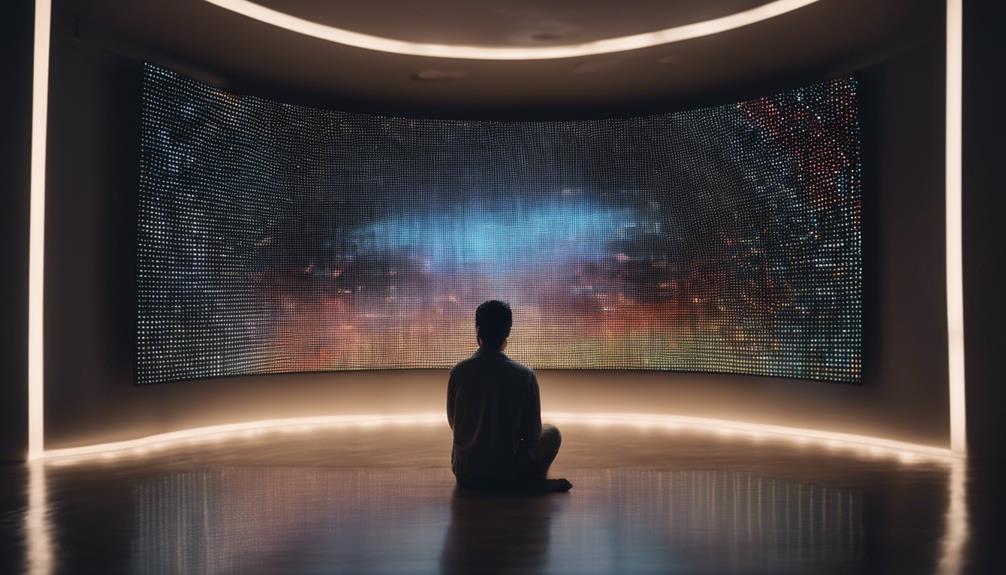
Examination to blue light emitted by LED screens raises concerns regarding its potential impact on retinal images, prompting a need for thorough evaluation of associated risks. LED screens are known to emit blue light, which has sparked discussions on how it may affect the delicate structures of the eye, particularly the retina.
While LED lights have reduced infrared emission compared to traditional lighting sources, the specific risk factors associated with prolonged exposure to LED screens are still being investigated. The influence of LED screen exposure on human bioprocesses, including sleep patterns and eye health, is a subject of ongoing research.
Although the radiance from LED screens typically falls within safe limits, experts caution that extended periods of exposure could potentially pose risks to eye health. As studies continue to explore the effects of blue light from LED screens on retinal images and overall well-being, it's essential for individuals to be mindful of their screen time to mitigate any potential negative impacts.
Concerns in Streetlights and Vehicles

LED lighting in streetlights and vehicles can raise concerns due to issues such as glare, brightness levels, and potential health impacts.
Poorly designed LED street lights can reduce visibility for drivers and pedestrians, posing safety risks.
Additionally, the brightness of LED headlights and lights in vehicles, especially in foggy conditions, can lead to glare problems that affect other road users.
Streetlight Glare Effects
The discomfort and eye fatigue caused by glare from LED streetlights, especially at high luminance levels, raise concerns in both streetlights and vehicles. Proper diffusion of high luminance LED lights is essential to avoid glare and guarantee safety on roads. Vehicle LED lights can also produce glare, impacting visibility for drivers, particularly in foggy conditions. European standards emphasize the importance of providing soft LED street lighting to minimize glare effects. Ensuring appropriate brightness levels and diffusion of LED streetlights can help reduce the risk of glare-related issues.
| Glare Effects | LED Streetlights |
|---|---|
| Discomfort | Eye Fatigue |
| High Luminance | Visibility |
LED Headlights Brightness
Concerns regarding the brightness of LED headlights in streetlights and vehicles persist, necessitating a focus on appropriate illumination levels to mitigate glare issues and enhance safety for all road users.
LED headlights must adhere to specific brightness levels to prevent excessive glare that could affect drivers and pedestrians. High luminance LED lights need proper diffusion to avoid blinding effects, particularly vital in foggy conditions where visibility is essential.
Poor quality LED lighting may result in glare problems, compromising the comfort and safety of individuals exposed to intense or misdirected light. European standards regulate optical radiation emission from LEDs, recognizing the risks of prolonged exposure, especially for children and teens.
Proper design and positioning of LED street lights are essential to minimize glare risks and ensure optimum lighting conditions on the roads.
Health Impacts of LEDS
Amid the increasing adoption of LED technology in streetlights and vehicles, the potential health impacts of these lighting systems are garnering attention. When considering the health implications of LED lighting, especially in streetlights and vehicles, several key points should be highlighted:
- LED street lights should provide soft lighting to reduce glare and promote safety for pedestrians and drivers.
- The brightness of LED street lights should be appropriately adjusted to prevent discomfort and potential vision issues.
- High luminance LED lights in vehicles should be diffused to minimize glare, especially in foggy conditions for safe driving.
- Poor quality LED lighting can cause discomfort and glare, affecting visual comfort and potentially leading to eye strain.
Thoughtful design and implementation of LED lighting are essential to mitigate health risks and ensure favorable lighting conditions for human well-being.
Vulnerable Groups at Risk

Children's eyes are more sensitive to the blue light emitted by LED sources, while older individuals may experience sleep disturbances due to prolonged exposure.
LED lights can potentially exacerbate medical conditions in vulnerable groups, such as teens and elderly individuals.
The impact of LED lighting on human bioprocesses, especially in these vulnerable groups, is currently being studied for a better understanding of potential risks.
Children's Eye Sensitivity
Children may experience heightened sensitivity to the blue light emitted by LED sources, which can pose risks to their visual health and overall well-being.
- Children's eyes are more sensitive to blue light compared to adults.
- Prolonged exposure to LED screens may lead to eye strain and discomfort.
- Blue light from devices can disrupt children's sleep patterns.
- Parents should consider monitoring parental control settings to limit children's exposure to LED lights.
Elderly Sleep Disturbances
Elderly individuals may face challenges with blue light exposure, potentially leading to disruptions in their sleep patterns. LED lights, commonly used in various settings, emit blue light that can interfere with the circadian rhythms of older individuals. Prolonged exposure to this type of light, especially in the evening, may impact the quality of sleep among the elderly. European standards have been established to limit the optical radiation emission from sources like LED lights to safeguard vulnerable groups, including the elderly, from potential harm. Older people may perceive LED lights as blurred, which can further affect their ability to rest well. It is essential to take into account these factors when addressing sleep disturbances in the elderly population.
| LED Lights | Elderly Sleep Disturbances |
|---|---|
| Blue light exposure | Disrupted sleep patterns |
| Circadian rhythms | Impact on sleep quality |
| European standards | Optical radiation emission |
| Blurred vision perception | Evening LED light disruption |
Medical Condition Exacerbation
Exposure to LED lighting can exacerbate existing medical conditions in vulnerable groups, potentially worsening symptoms and health outcomes.
- Children, teens, and older individuals are considered vulnerable groups at risk for potential exacerbation of existing medical conditions due to LED lighting exposure.
- European standards restrict optical radiation emission from toys to safeguard children from harm caused by LED lights.
- Teens exposed to LED sources for long periods may experience exacerbated symptoms of medical conditions.
- Older people, particularly those with pre-existing eye conditions, may perceive LED lights as blurry, leading to increased discomfort or worsened symptoms.
Vulnerable groups should take precautions to minimize exposure to LED lighting, reducing the risk of exacerbating medical conditions and potential health issues.
Disruption of Natural Sleep Patterns
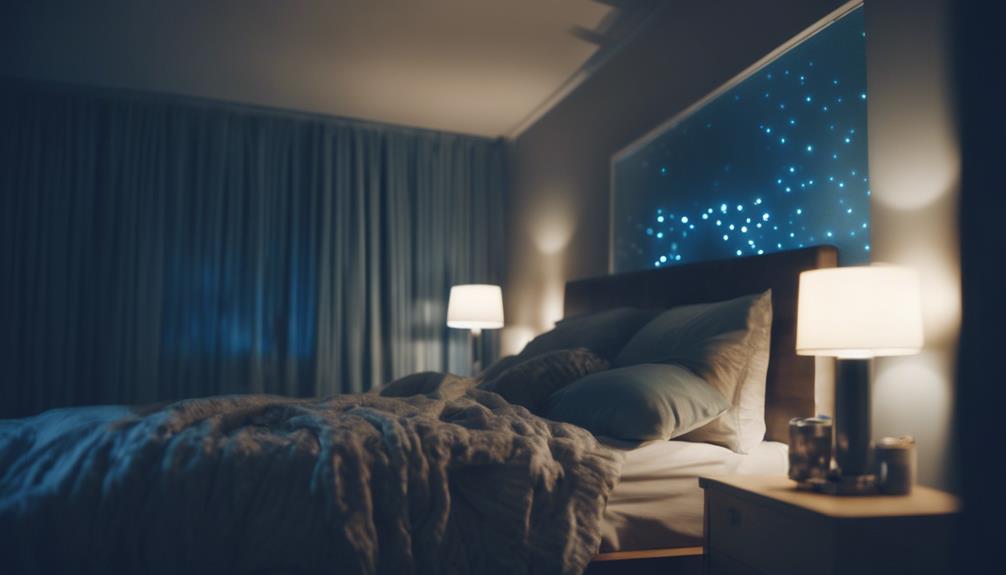
Blue light emitted by LED lighting in the evening disrupts natural sleep patterns by suppressing melatonin production. When exposed to blue light, especially before bedtime, the body's production of melatonin, a hormone that regulates sleep-wake cycles, is hindered. This disruption can mislead the brain into believing it's still daytime, making it challenging to initiate sleep. Consequently, individuals may experience difficulties falling asleep, leading to fatigue, mood disturbances, and potential long-term health issues.
Using devices with LED screens before sleep can further exacerbate this problem by delaying the body's internal clock, affecting both the quality and duration of sleep. To maintain healthy sleep patterns and overall well-being, it's essential to minimize blue light exposure from LED lights in the evening. By adopting strategies such as reducing screen time, using blue light filters, or employing warm-toned lighting in the evening, individuals can mitigate the negative impacts of LED lighting on their natural sleep rhythms.
Effects on Skin From LED Lights

The potential harm to the skin from LED lights, particularly those emitting UV light, raises concerns about skin safety and health effects. The skin is the body's largest organ and is sensitive to various forms of light, including UV rays. When exposed to UV light from LEDs, several effects on the skin can occur:
- Increased risk of skin damage and potential skin cancer due to prolonged exposure to UV light.
- Accelerated skin aging, including the development of wrinkles, fine lines, and age spots.
- Potential for UV-LED lights used in cosmetic treatments to have unknown health effects on the skin.
- Limited data available regarding the risks of UV light exposure for professionals who frequently use UV-LED lights.
Given these concerns, monitoring UV light exposure from LED devices, especially in cosmetic procedures, is essential to mitigate potential health risks and guarantee skin safety. The SCENIHR review in 2012 highlighted the importance of understanding the health effects of artificial light, emphasizing the need for further research on UV emissions from LEDs.
Frequently Asked Questions
Is LED Lighting Bad for Your Health?
LED lighting can impact health, particularly sleep and eye health. Blue light from LEDs can disrupt the body's circadian rhythm, affecting sleep patterns. Excessive exposure to blue light, especially in the evening, may hinder melatonin production, leading to sleep disturbances.
Prolonged exposure to blue light can also contribute to eye damage over time. Conditions like depression and diabetes have been linked to disruptions in the body clock caused by blue light exposure.
Is It Safe to Have LED Lights in Your Room?
Having LED lights in a room is generally safe. Properly chosen LED bulbs can reduce potential health risks. Avoiding prolonged exposure to bright LED lights at night is essential for eye health and sleep quality.
Blue light from LEDs can disrupt circadian rhythms, so warm-toned LEDs are ideal for bedrooms. By taking simple precautions, individuals can enjoy the benefits of LED lighting while minimizing any associated health concerns.
How Do LED Lights Affect the Brain?
LED lights affect the brain by emitting blue light that can disrupt the production of melatonin, a hormone essential for regulating sleep.
Exposure to this blue light before bedtime can suppress melatonin release, making it harder to fall asleep and impacting overall sleep quality.
Prolonged exposure to LED lighting may interfere with the brain's natural circadian rhythm, potentially leading to cognitive impairment and mood disorders due to disrupted sleep patterns.
Are LED Lights Harmful to Human Eyes?
LED lights can potentially harm human eyes due to their blue light emission. Prolonged exposure may lead to eye strain, discomfort, and disrupt sleep patterns. Factors such as spectrum, intensity, and duration of exposure play a role in eye health impact.
Using LED lights with lower color temperature and proper shielding can help reduce the risk of damage. It's crucial to be mindful of these factors to protect one's eyes from potential harm.
Conclusion
To wrap up, while LED lighting offers energy-efficient benefits, it's important to be mindful of its potential harm. The blue light emitted can disrupt sleep patterns and impact overall health.
It's vital for individuals to limit exposure, especially before bedtime, to maintain a healthy circadian rhythm. Remember, just as too much sunshine can burn, excessive LED light exposure can also harm.
Stay informed and protect yourself from the potential risks of LED lighting.
Lighting
LED Lights for Aquariums: Are They Beneficial?
Explore with us the perks of LED lights for your aquatic pals! Discover if are led lights good- for aquariums and how they can enhance your tank’s beauty.
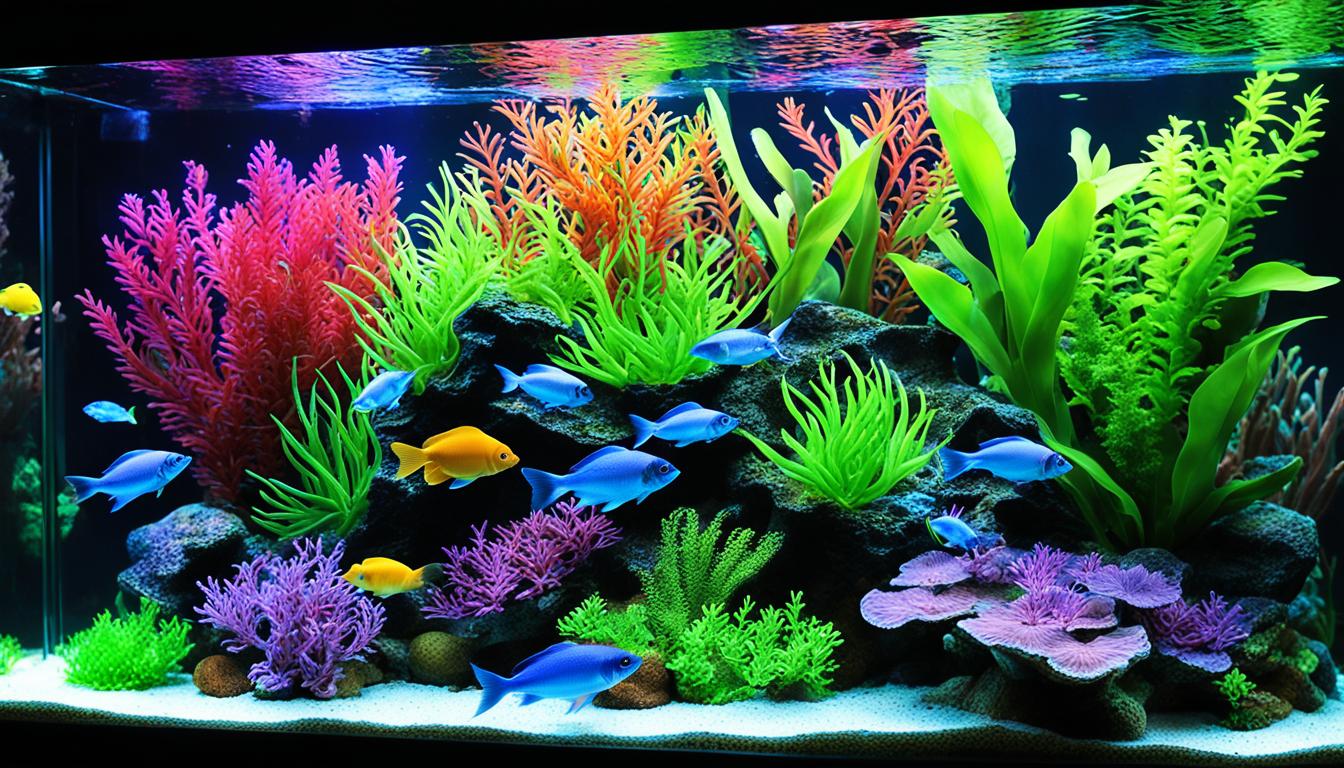
Welcome to our guide on LED lights for aquariums! If you’re a fish enthusiast or an avid aquarium hobbyist, you may be wondering if LED lights are truly beneficial for your underwater ecosystem. Do they offer more than just lighting? Can they enhance the growth of plants and bring out the brilliant colors of your fish? Today, we’ll delve into the world of LED lighting and explore the numerous advantages they bring to your aquarium.
Key Takeaways:
- LED lights provide energy savings, vibrant color effects, and a long lifespan for your aquarium.
- They come in various color spectrums, allowing for customized lighting options.
- Dimming capabilities in LED lights can adjust brightness and create blending effects.
- Proper ventilation is important to maintain the performance and lifespan of LED lights.
- LED lighting can enhance coral growth and bring out the beautiful colors in fish.
The Benefits of LED Lighting for Aquariums
LED lighting offers several benefits for aquariums. Not only do they provide energy savings, but they also enhance the visual appeal of your tank with vibrant colors and shimmer effects. LEDs have a long lifespan, lasting up to 50,000 hours, which means you won’t have to replace them frequently. The ability to dim LEDs allows you to adjust brightness and create different lighting effects, giving you full control over the atmosphere in your aquarium.
Proper ventilation is crucial when using LED lighting to keep them cool and maintain their performance over time. By promoting coral growth and bringing out the colors in your fish, LED lights create a captivating and dynamic underwater environment.
In addition to the aesthetic benefits, LED lighting is a cost-effective choice for aquariums. Compared to traditional lighting options, LEDs consume less energy and can save you money on electricity costs in the long run. Their efficiency and longevity make them an excellent investment for any aquarium enthusiast.
Overall, LED lighting offers a visually appealing, customizable, and cost-effective solution for enhancing the beauty of your aquarium. Let’s explore the different factors to consider when choosing the right LED lights for your specific needs.
| Benefits | LED Lighting | Traditional Lighting |
|---|---|---|
| Energy Efficiency | ✓ | ✗ |
| Long Lifespan | ✓ | ✗ |
| Customizability | ✓ | ✗ |
| Cooler Operation | ✓ | ✗ |
| Aquarium Aesthetics | ✓ | ✗ |
| Cost Savings | ✓ | ✗ |
Choosing the Right LED Lights for Your Aquarium
When it comes to selecting LED lights for your aquarium, several factors should be taken into consideration. These factors include the color spectrum, light intensity, and light spread of the LED lights. By understanding these aspects, you can choose LED lights that are best suited for your aquarium’s unique needs and create an optimal environment for your aquatic companions.
Color Spectrum
The color spectrum of LED lights plays a crucial role in enhancing the visual appeal of your aquarium. LED lights are available in various color options, such as warm white, cool white, blue, and red. Each color spectrum can have a different effect on the colors of your fish and plants. It’s important to choose LED lights that complement the natural colors and patterns of your aquatic life, creating a vibrant and captivating underwater display.
Light Intensity
The light intensity of LED lights refers to the brightness or luminosity they emit. Different plants have varying light intensity requirements for optimal growth. Low light plants, such as Anubias and Java Moss, thrive in environments with lower light intensity. On the other hand, high light plants like Amazon Sword and Dwarf Baby Tears require more intense lighting, often paired with carbon dioxide injection. Consider the plant species you intend to keep and select LED lights with the appropriate light intensity to promote healthy growth.
Light Spread
Light spread is another important consideration when choosing LED lights for your aquarium. It refers to how evenly the light is distributed throughout the tank. Each part of the aquarium, including the substrate and background, should receive sufficient light to support the growth of both plants and aquatic life. LED lights with a wide light spread ensure that all areas of the aquarium are adequately illuminated, promoting balanced growth and enhancing the overall aesthetic appeal of the tank.
LED lights offer a great deal of flexibility in terms of color spectrum, light intensity, and light spread. This versatility allows you to customize your aquarium’s lighting to meet the specific needs of your aquatic ecosystem. By carefully considering these factors and selecting LED lights that align with your aquarium’s requirements, you can create a visually stunning and thriving underwater world for your fish and plants.
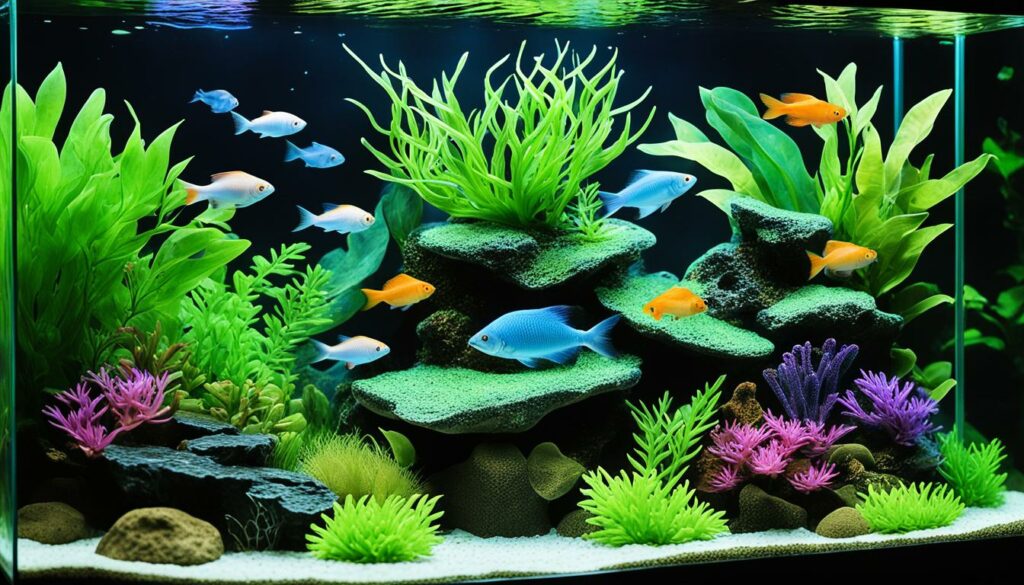
| Factor | Considerations |
|---|---|
| Color Spectrum | Choose LED lights that enhance the colors of your fish and plants. |
| Light Intensity | Consider the light intensity requirements of your plant species for optimal growth. |
| Light Spread | Ensure all areas of the aquarium receive sufficient light for balanced growth. |
The Advantages of LED Lights for Freshwater Aquariums
LED lights have several advantages for freshwater aquariums. Firstly, they consume less energy compared to traditional lighting options, resulting in cost savings for aquarium owners. This is especially beneficial for aquariums that require lighting for long periods throughout the day. LED lights are highly energy-efficient, converting a higher percentage of electricity into visible light, making them a sustainable lighting choice.
Another advantage is that LED lights produce less heat compared to other lighting options. This is crucial for maintaining the optimal temperature of the aquarium water and preventing overheating. LED lights emit significantly less heat, reducing the risk of stressing or harming the aquatic inhabitants.
LED lights also have a significantly longer lifespan compared to traditional lighting options. On average, LED lights can last up to 50,000 hours, eliminating the need for frequent bulb replacements. This not only saves money but also reduces the hassle of constantly changing bulbs and ensures consistent lighting for the aquarium.
One of the key advantages of LED lights is their ability to be dimmed and programmed. This allows aquarium owners to customize the lighting effects according to their preferences and mimic natural daylight cycles. Dimming the lights can create a calming ambiance, especially during nighttime, providing a more natural habitat for the aquatic life. Programming the lights to change intensities or colors throughout the day can also create visually engaging effects and enhance the overall aesthetic appeal of the aquarium.
LED lights are available in a variety of colors, allowing aquarium owners to accentuate different aspects of the tank. Whether it’s highlighting the vibrant colors of the fish or creating a specific ambiance with colored lighting, LED lights offer versatility in terms of color options.
Furthermore, LED lights provide broad coverage, ensuring all parts of the aquarium receive sufficient light. This is important for promoting healthy plant growth in freshwater aquariums and ensuring that no areas are left in shadow. With LED lights, you can create an evenly lit environment for both the fish and the plants, enhancing the overall visual appeal of the aquarium.
Overall, LED lights offer numerous advantages for freshwater aquariums, including energy efficiency, reduced heat output, long lifespan, customizable lighting effects, color options, and broad coverage. These advantages make LED lighting an excellent choice for aquarium owners who want to create an efficient, visually appealing, and healthy environment for their aquatic pets.
Factors to Consider When Choosing LED Lights for Planted Aquariums
Choosing the right LED lights for your planted aquarium is crucial to ensure optimal growth and health of your underwater plants. There are several key factors that you should consider when making your selection:
1. Color Spectrum
The color spectrum of the LED lights plays a significant role in promoting photosynthesis and plant growth. Neutral white lights with color temperatures ranging from 5000 to 6500 K are often preferred for planted aquariums as they closely simulate natural daylight. This range provides the sufficient light wavelengths needed for chlorophyll absorption and ensures that your aquatic plants receive the right amount of light energy.
2. Light Intensity
The light intensity required depends on the types of plants you intend to cultivate in your aquarium. Low light plants, such as Java Fern and Anubias, are ideal for beginner-friendly setups and require lower light intensity. On the other hand, high light plants like Carpeting Dwarf Hairgrass and Ludwigia require higher light intensity and may necessitate the use of CO2 injection systems. Consider the light intensity requirements of your chosen plants to ensure they receive adequate light for healthy photosynthesis.
3. Light Spread
Light spread refers to how far the light emitted by the LED fixtures reaches within the aquarium. It is important to choose LED lights with a wide light spread to ensure that all areas of your planted aquarium receive sufficient light. This is particularly important for larger tanks as they require a higher light spread to cover the entire surface area effectively. Adequate light spread prevents uneven growth and ensures that all your plants receive consistent illumination.
Our Recommendation:
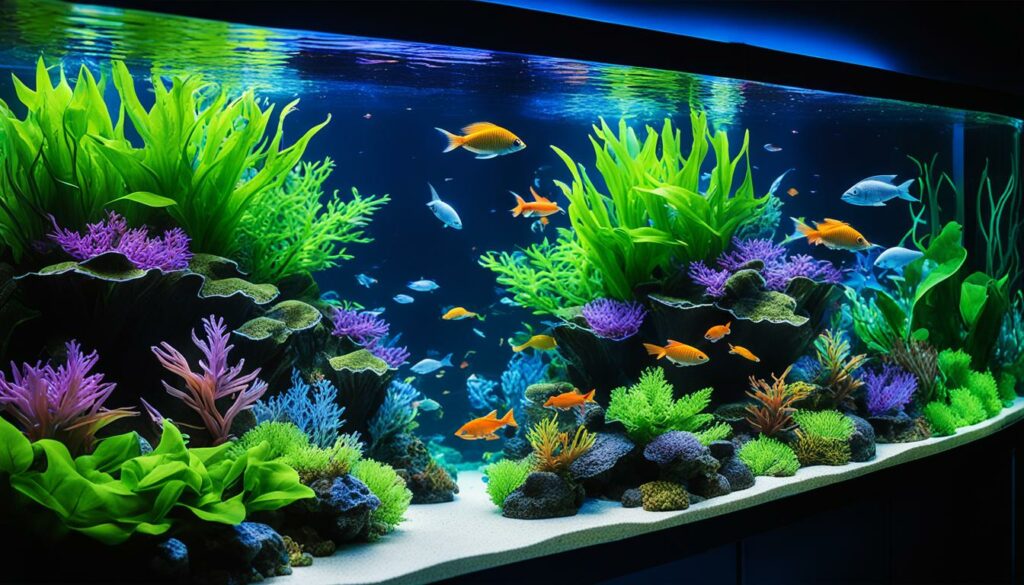 For those seeking a reliable LED light option for planted aquariums, we recommend the Finnex Planted+ 24/7 LED Aquarium Light. This LED light fixture offers a wide color spectrum, adjustable light intensity, and an even light spread, making it ideal for nurturing a variety of aquatic plants. The Finnex Planted+ 24/7 also features a convenient 24-hour lighting cycle with customizable settings, allowing you to simulate natural daylight and improve the health and vibrancy of your plants.
For those seeking a reliable LED light option for planted aquariums, we recommend the Finnex Planted+ 24/7 LED Aquarium Light. This LED light fixture offers a wide color spectrum, adjustable light intensity, and an even light spread, making it ideal for nurturing a variety of aquatic plants. The Finnex Planted+ 24/7 also features a convenient 24-hour lighting cycle with customizable settings, allowing you to simulate natural daylight and improve the health and vibrancy of your plants.
Consider the factors mentioned above when choosing LED lights for your planted aquarium to create a thriving underwater oasis for your aquatic plants.
Pros and Cons of LED Lighting for Freshwater Aquariums
LED lighting for freshwater aquariums offers several advantages that make it a popular choice among aquarium enthusiasts. However, it also has some limitations to consider. Let’s take a closer look at the pros and cons of LED lighting for freshwater aquariums.
Pros of LED Lighting for Freshwater Aquariums:
- Low energy consumption: LED lights are highly energy-efficient, consuming less electricity compared to traditional lighting options. This not only reduces your electricity bills but also minimizes your environmental impact.
- Low heat output: LED lights generate minimal heat, reducing the risk of overheating the aquarium and affecting the water temperature. This creates a more stable and comfortable environment for your aquatic pets.
- Long lifespan: LED lights have an impressive lifespan, lasting up to 50,000 hours or more. This means you won’t need to replace bulbs frequently, saving you money in the long run.
- Adjustable light intensity: LED lights allow you to adjust the brightness and create different lighting effects. This flexibility enables you to provide the ideal lighting conditions for your plants, fish, and overall aesthetic preferences.
- Various color options: LED lights come in a wide range of colors, allowing you to customize the lighting scheme for your aquarium. This can enhance the visual appeal of your tank and highlight the vibrant colors of your fish and plants.
Cons of LED Lighting for Freshwater Aquariums:
- Higher initial cost: LED fixtures may have a higher upfront cost compared to traditional lighting options. However, the long-term energy savings and extended lifespan of LEDs offset the initial investment.
- Limitations for high-light planted aquariums: Some LED lighting fixtures may have limitations for high-light planted aquariums that require intense lighting conditions. It’s essential to choose LED lights that can provide the necessary light intensity for your specific plant species.
Despite these limitations, LED lighting remains a popular choice for freshwater aquariums due to its energy efficiency, longevity, and customizable features. By carefully considering the specific needs of your aquarium and choosing the right LED lighting setup, you can enjoy the benefits of LED lighting while creating a visually stunning and thriving aquatic environment.
| Pros | Cons |
|---|---|
| Low energy consumption | Higher initial cost |
| Low heat output | Limitations for high-light planted aquariums |
| Long lifespan | |
| Adjustable light intensity | |
| Various color options |
While there are some drawbacks to consider, the benefits of LED lighting for freshwater aquariums make it a worthwhile investment. With energy savings, long lifespan, and customizable features, LED lighting can enhance the beauty and health of your aquatic ecosystem.
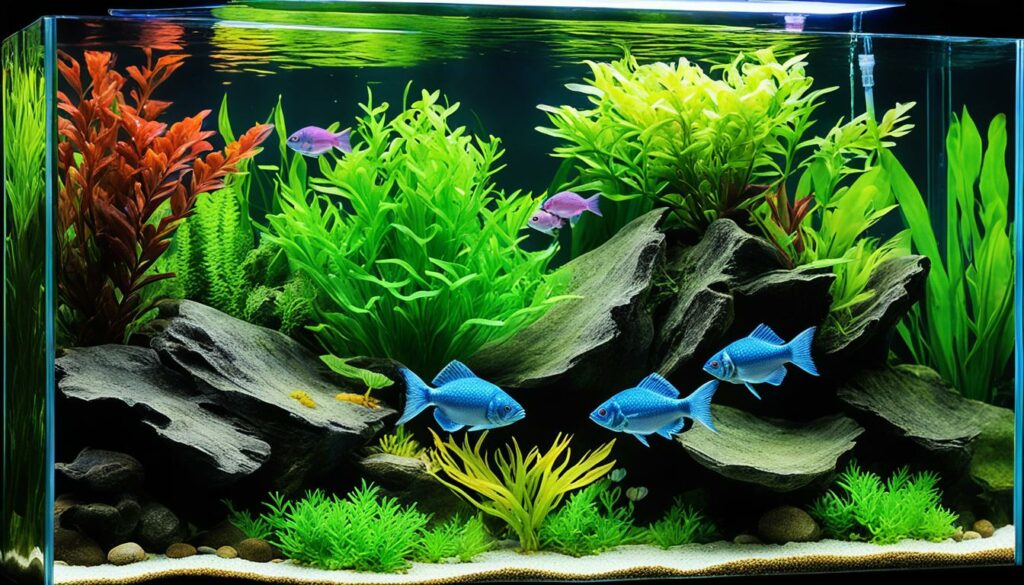
Understanding Color Spectrum and Light Intensity in LED Lighting for Aquariums
Color spectrum and light intensity play crucial roles in achieving optimal lighting conditions for aquariums with LED lighting. The color spectrum refers to the range of colors produced by the light, while light intensity determines the brightness level. Understanding these factors is essential for creating the perfect environment for your aquatic plants and fish.
When it comes to the color spectrum, many hobbyists prefer neutral white lights in the 5000 to 6500 K range. These lights simulate natural daylight, which is ideal for plant growth and enhances the colors of your fish and plants. The neutral white spectrum provides a balanced and visually appealing aesthetic to your aquarium.
Light intensity, measured in PAR (Photosynthetically Active Radiation), is another key consideration. Different plants have varying light intensity requirements. For beginners or low-light plants, a lower light intensity is suitable. On the other hand, high-light plants require more intense lighting. It’s essential to strike a balance between providing enough light for plant growth and avoiding excessive light that can lead to algae growth.
LED lighting offers the flexibility to adjust both color spectrum and light intensity to meet the specific needs of your aquarium. This ability to tailor the lighting conditions allows you to create an environment that promotes healthy plant growth while showcasing the vibrant colors of your fish.
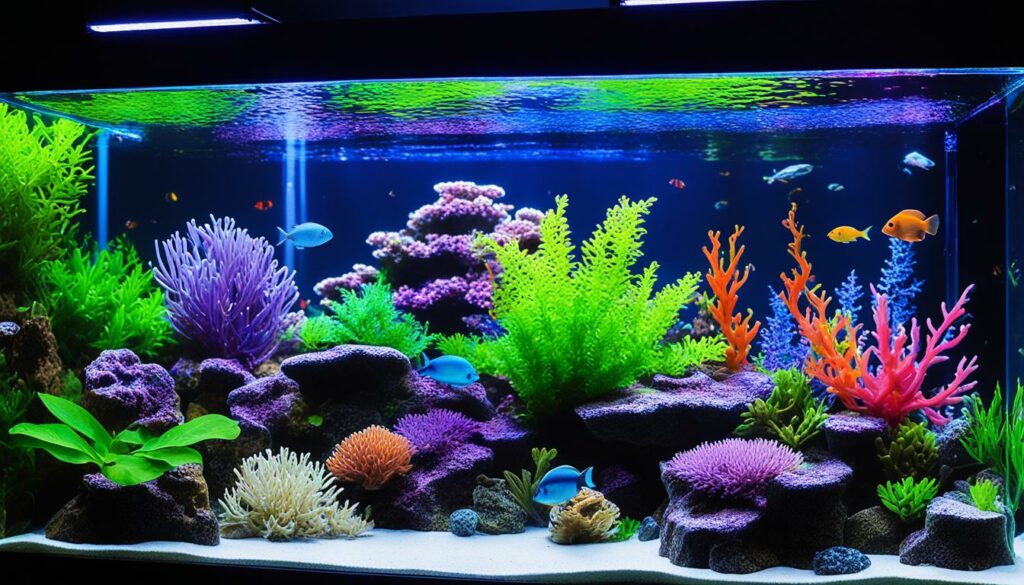
“LED lighting allows us to fine-tune the color spectrum and light intensity to create an optimal environment for our aquatic plants and fish.”
The Importance of Light Spread in LED Lighting for Aquariums
When it comes to LED lighting for aquariums, one crucial factor to consider is light spread. Light spread refers to how far the light reaches in the tank, ensuring that all parts of the aquarium receive sufficient light. Proper light spread is essential for creating an optimal environment for your aquatic life and enhancing the overall visual aesthetics of the tank.
Most LED lights have a light spread of around 1 foot directly beneath them. While this may be adequate for smaller tanks, larger aquariums may require multiple lights or a high-quality LED light with a wider light spread. It’s important to take the dimensions of your aquarium into account when choosing LED lights to ensure that every corner of the tank is adequately illuminated.
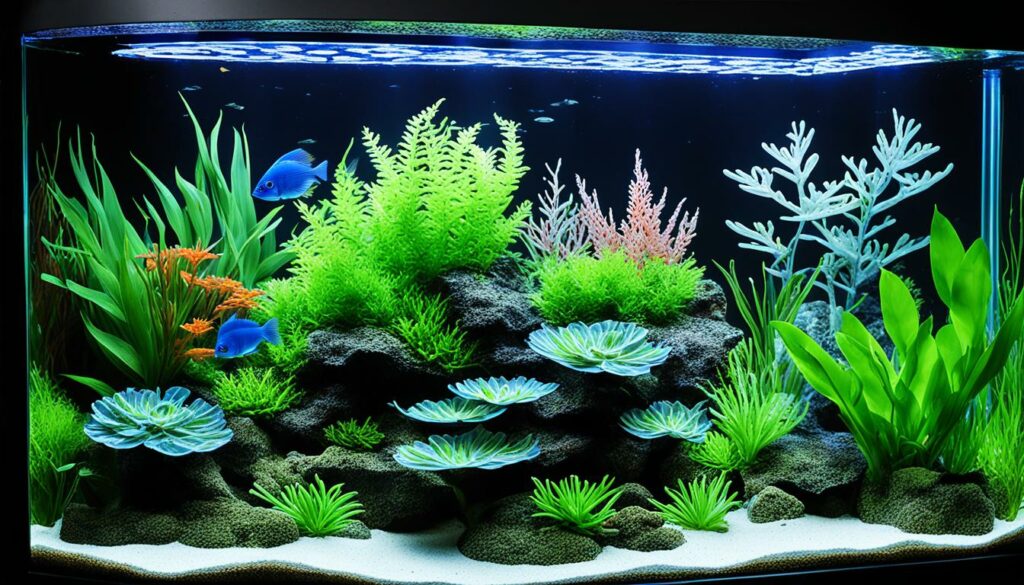
Why is light spread so important? Well, it directly affects the growth and health of the plants in your aquarium. Plants require sufficient light to undergo photosynthesis, which is crucial for their growth and survival. Proper light spread ensures that all plants receive the light they need to thrive, preventing any areas of shadow or insufficient illumination.
Additionally, light spread plays a significant role in the visual appeal of your aquarium. Adequate lighting coverage allows the vibrant colors of your fish and plants to shine through, creating a stunning and captivating display. It helps to create depth and dimension in the tank, making it visually pleasing and aesthetically appealing.
Tips for Achieving Optimal Light Spread:
- Consider the size and dimensions of your aquarium when choosing LED lights. Ensure that the light fixtures can adequately cover the entire tank.
- For larger aquariums, opt for LED lights with a wider light spread or consider using multiple lights strategically placed to evenly distribute the light.
- Ensure that the chosen LED lights have adjustable mounting options to allow for proper positioning and angle adjustment to achieve uniform light distribution.
- Regularly monitor the light distribution within the tank and make any necessary adjustments to ensure optimal coverage.
In conclusion, understanding the importance of light spread in LED lighting for aquariums is crucial for creating a thriving and visually appealing aquatic environment. By choosing LED lights with the right light spread and ensuring proper coverage, you can provide the ideal lighting conditions for your fish and plants to flourish.
Choosing the Best LED Aquarium Light: A Recommendation
After careful evaluation, we recommend the Aquarium Co-Op Easy Plant LED as the best LED aquarium light option. This light strikes the perfect balance between simplicity, affordability, and performance, making it an excellent choice for both beginner and experienced aquarium enthusiasts.
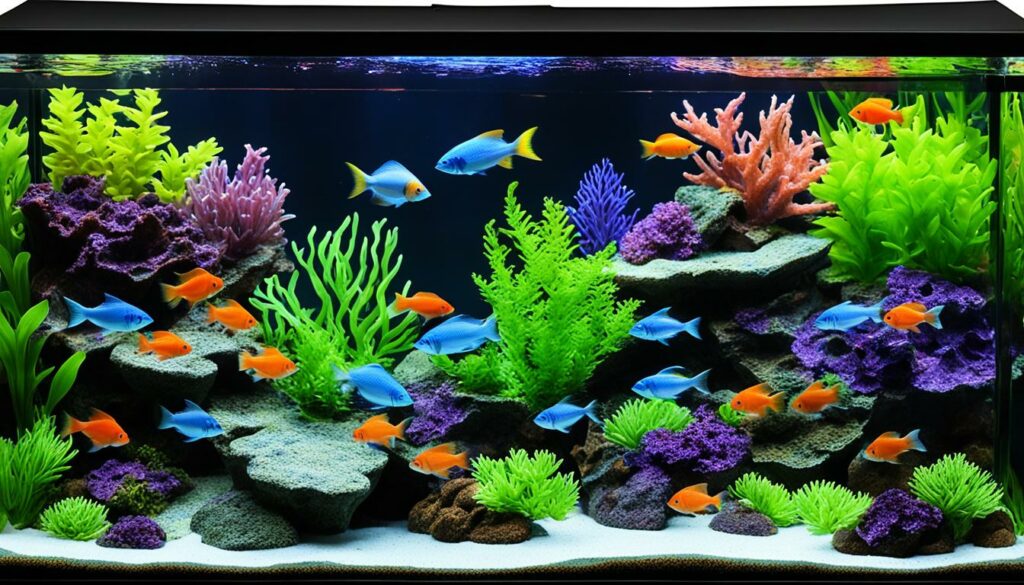
The Aquarium Co-Op Easy Plant LED features a color spectrum of 5300 K, which closely resembles natural sunlight. This spectrum enhances the vibrant colors of your fish and plants, creating a visually stunning underwater environment. Whether you have a freshwater or planted aquarium, this light will beautifully showcase your aquatic inhabitants.
One of the standout features of the Aquarium Co-Op Easy Plant LED is its exceptional quality. It comes with a 3-year warranty, providing peace of mind and a guarantee of long-lasting performance. The light is also IP67 water-resistant and has ETL certification for safety standards, ensuring a reliable and secure lighting solution for your aquarium.
With adjustable brightness capabilities, this LED light caters to the needs of both low light and high light plants. You can easily customize the light intensity to promote healthy plant growth and create the desired ambiance in your aquarium.
In addition to its performance, the Aquarium Co-Op Easy Plant LED is designed with energy efficiency in mind. The power-efficient LEDs consume less electricity, resulting in cost savings on your energy bills. The housing design effectively dissipates heat, keeping the light cool and prolonging its lifespan.
For added convenience, the Aquarium Co-Op Easy Plant LED comes with a 12-foot power cable. This flexibility allows you to easily reach wall outlets and set up your aquarium lighting system according to your specific needs.
The Aquarium Co-Op Easy Plant LED is a reliable and high-quality LED aquarium light that offers exceptional performance while remaining budget-friendly. It ticks all the boxes you’d expect in a top-notch lighting solution, making it our top recommendation for anyone in search of the best LED aquarium light.
Conclusion
LED lights are highly beneficial for aquariums, providing energy savings, vibrant color effects, and a long lifespan. Their versatility in terms of color spectrum, light intensity, and light spread makes them an excellent choice for various aquarium setups. Planted aquariums especially benefit from LED lights as they support plant growth and enhance the visual appeal of the tank.
When selecting LED lights, it is important to consider factors such as color spectrum, light intensity, and light spread to ensure they meet the specific needs of your aquarium. The right LED lights can bring out the beauty of your fish and plants while providing the optimal lighting conditions for their growth.
If you’re looking for a recommended LED light option that combines simplicity, affordability, and performance, we suggest considering the Aquarium Co-Op Easy Plant LED. With its 5300 K color spectrum, adjustable brightness, and energy-efficient design, it offers everything you need to enhance the beauty of your aquarium. Embrace the benefits of LED lighting and create a stunning underwater oasis in your home.
FAQ
What are the benefits of LED lighting for aquariums?
What factors should I consider when choosing LED lights for my aquarium?
What are the advantages of LED lights for freshwater aquariums?
What factors should I consider when choosing LED lights for planted aquariums?
Are there any drawbacks to using LED lighting for freshwater aquariums?
What is the importance of color spectrum and light intensity in LED lighting for aquariums?
Why is light spread important in LED lighting for aquariums?
Can you recommend a good LED aquarium light?
Vivienne – Your Content Companion Vivienne is your content companion, curating valuable tips, advice, and inspiration to guide you on your home decor journey. From insightful blog posts to informative product descriptions, she’s here to empower you with the knowledge you need to create your dream space.
Lighting
Will Plants Grow Under LED Lighting?
Plants flourish under LED lighting, receiving essential red and blue light for growth—uncover how LED lights revolutionize indoor gardening.
Plants thrive well under LED lighting as it emits essential red and blue light important for growth and photosynthesis. LED grow lights efficiently provide the light intensity needed for indoor plants to flourish, typically ranging from 1000-1500 lux. Their customizable features accommodate various plant species, enhancing growth stages. Studies show plants respond favorably to LED lights, growing faster and taller. Energy-efficient and cost-effective, LED lights simulate natural sunlight, supporting healthy indoor plant development. Discover more about how LED grow lights revolutionize indoor gardening and promote ideal plant growth.
Key Takeaways
- LED lighting provides essential red and blue spectrums for plant growth.
- Plants thrive under LED lights with 1000-1500 lux light intensity.
- Customizable LED options cater to different plant species' unique light requirements.
- Studies demonstrate increased height and growth rates in plants under LED lighting.
- Energy-efficient LED grow lights support healthy plant development indoors.
Understanding Plant Light Requirements
Indoor plants thrive when exposed to specific light spectrums like blue and red, essential for growth under LED lighting. LED grow lights efficiently emit these necessary light spectrums, promoting ideal plant growth. Most indoor plants require 1000-1500 lux of light intensity to thrive, a range easily achievable with LED lighting setups. The ability to customize LED grow lights allows for precise adjustments to meet the unique light requirements of different plant species.
LED lights offer a longer lifespan compared to traditional lighting options, making them a cost-effective and sustainable choice for indoor gardening. Understanding the photoperiod, or the duration of light exposure, is important as it varies among plant species. By providing the right balance of blue and red light spectrums, LED grow lights ensure that plants receive the necessary energy for photosynthesis and overall growth.
To conclude, LED lighting plays a significant role in providing the specific light spectrums essential for indoor plants to thrive and reach their full growth potential.
The Science Behind LED Grow Lights
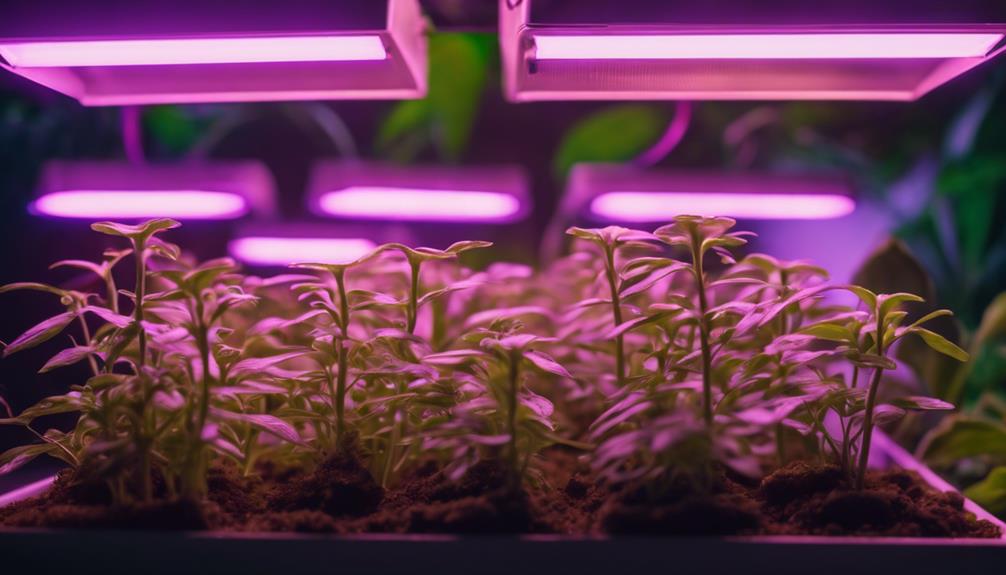
LED grow lights are designed to emit specific red and blue spectrums essential for plant growth. The efficient light intensity provided by LEDs, typically 1000-1500 lux, contributes to plants thriving under this lighting.
LED grow lights can be customized to meet the specific light requirements of different plant species.
Light Spectrum Efficiency
Efficiently emitting specific light spectrums essential for plant growth, LED grow lights revolutionize indoor gardening with their tailored spectrum customization. LED grow lights are designed to provide plants with the most efficient light spectrum efficiency they need to thrive.
By emitting targeted wavelengths of red and blue light, these lights closely mimic the natural sunlight that plants require for photosynthesis. Studies by NASA have shown that plants respond exceptionally well to LED lighting, growing faster and taller compared to traditional light sources.
The customizable spectrum of LED grow lights allows for different light intensities to support various growth stages of plants. Not only are LED grow lights energy-efficient and cost-effective, but they also play a crucial role in promoting healthy plant growth indoors.
Plant Growth Benefits
How do plants benefit from the specific blue and red light spectrums emitted by LED grow lights for their growth and photosynthesis?
LED grow lights offer a complete spectrum of light that includes these essential wavelengths, promoting ideal photosynthesis and overall plant development.
By providing the necessary light intensity and spectrum, LED grow lights support plants in thriving indoors.
The customizable options, such as blurple, white, and COB lights, cater to different growth stages, ensuring plants receive the specific light they need for each phase.
Studies, including those conducted by NASA, have demonstrated that plants grown under LED lights exhibit increased height and growth rates compared to other lighting sources.
This makes LED grow lights a preferred choice for indoor plant growth, offering energy efficiency, cost-effectiveness, and longevity.
Energy Consumption Comparison
Comparing energy consumption between LED grow lights and traditional lighting options reveals a significant advantage in favor of LED technology. LED grow lights consume up to 50% less energy than traditional options, showcasing their superior energy efficiency.
This efficiency not only reduces energy costs but also lessens the environmental impact of lighting systems. LED lights excel at converting energy into light, making them a sustainable choice for indoor plant growth.
The lower energy consumption of LED lights translates into cost savings over time, making them an economically viable option. Additionally, as LED lighting technology continues to advance, further improvements in energy efficiency are expected, solidifying LED grow lights as a top choice for energy-conscious indoor gardening enthusiasts.
Types of LED Grow Lights
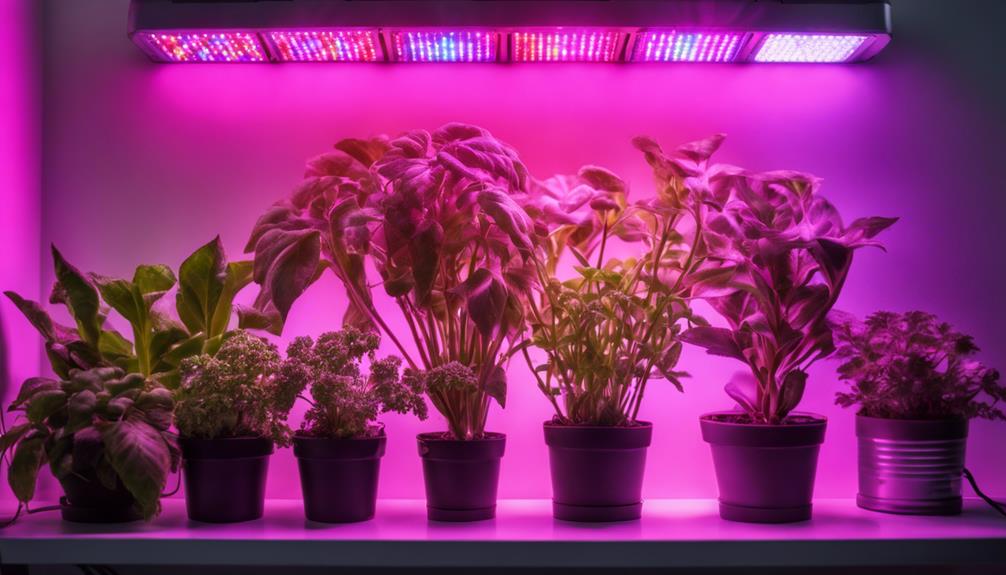
Different types of LED grow lights, such as Full-Spectrum, Blurple, White, and COB LEDs, cater to various plant requirements. Full-Spectrum LEDs provide a wide range of light beneficial for all growth stages, closely mimicking natural sunlight. White LEDs offer a balanced spectrum that promotes overall plant health and is ideal for visual inspection. Blurple LEDs, a mix of blue and red lights, are excellent for flowering and fruiting stages due to their targeted spectrum. COB LEDs, with multiple chips in one module, offer high intensity and are suitable for larger growing areas. These LED lights are energy-efficient, emit low heat, and can be customized for specific plant needs. The table below summarizes the key characteristics of each type:
| LED Type | Description | Ideal Growth Stage |
|---|---|---|
| Full-Spectrum | Wide light range mimicking sunlight, suitable for all growth stages | Germination, Growth, Flower |
| White | Balanced spectrum promoting overall plant health, ideal for visual inspection | General plant health |
| Blurple | Mix of blue and red lights, great for flowering and fruiting stages | Flowering, Fruiting |
| COB | High intensity with multiple chips, suitable for larger growing areas | Larger growing areas |
LED grow lights offer versatility and efficiency, making them a popular choice for indoor plant cultivation.
Benefits of Using LED Grow Lights
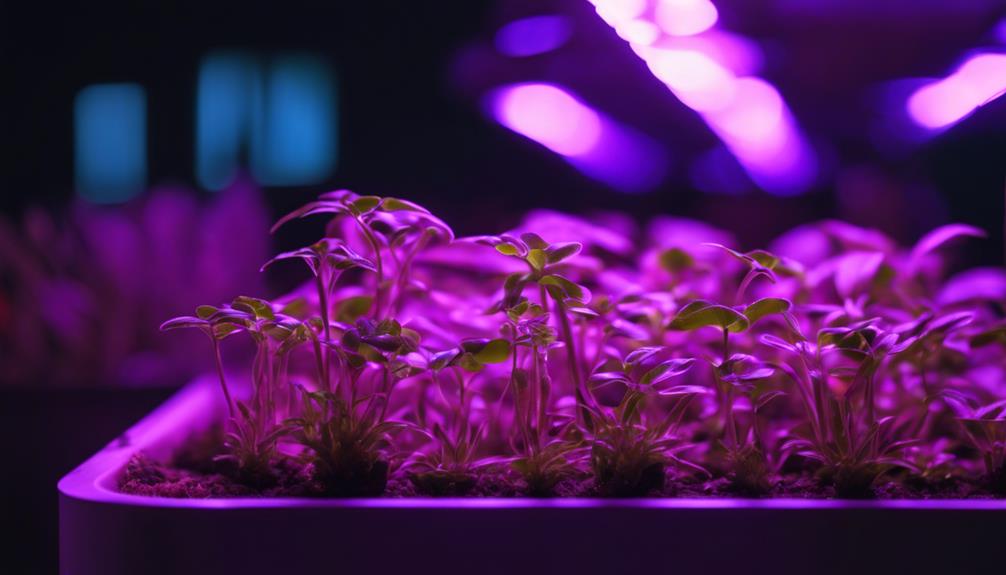
LED grow lights are an energy-efficient lighting option that promotes plant growth by emitting a well-suited light spectrum. These lights have a longer lifespan and offer customizable spectrum options to cater to different plant growth stages.
Studies, including those conducted by NASA, have shown that plants grow taller and faster under LED lights.
Energy-Efficient Lighting Option
Using LED grow lights provides an energy-efficient lighting option for indoor gardening, offering numerous benefits for plant growth. LED lights are known for being energy efficient, consuming less power than traditional grow lights while still providing ideal light for plants. They also have a longer lifespan, reducing the need for frequent replacements and saving on maintenance costs in the long run.
Another advantage of LED grow lights is their minimal heat emission, which prevents damage to plants and allows for closer placement without the risk of burning. Additionally, these lights offer a customizable spectrum, enabling users to adjust the light output based on specific plant needs and growth stages.
Studies have shown that plants grow taller and faster under LED lights, making them a reliable choice for indoor gardening.
Optimal Light Spectrum
Providing plants with the ideal light spectrum is essential for maximizing their growth potential indoors. LED grow lights offer a range of benefits for plant growth, including:
- LEDs provide the necessary red and blue light spectrums for best plant growth.
- They offer customizable spectrums to cater to different plant requirements.
- NASA studies demonstrate that plants grow taller and faster under LED lights, showcasing their effectiveness.
- LED lights are energy-efficient and cost-effective compared to traditional grow lights.
- Plants require specific light spectrums like white, red, and blue for growth, flowering, and fruit production, all of which LED grow lights can provide.
Promotes Plant Growth
Enhancing plant growth and well-being, LED grow lights promote healthy development through their specific red and blue light spectrums. These lights are tailored to meet the precise needs of plants, stimulating photosynthesis and overall growth.
Compared to traditional lighting, LED lights encourage plants to grow taller and quicker, showcasing their effectiveness in supporting plant vitality. Additionally, the energy-efficient nature of LED lights not only benefits the environment but also makes them a cost-effective option for promoting plant growth.
NASA studies further validate the positive impact of LED lights on plant productivity, emphasizing their significance in agriculture and horticulture. With customizable spectrums available for different growth stages, LED grow lights provide ideal conditions for plants to thrive and reach their full potential.
Tips for Using LED Grow Lights Effectively
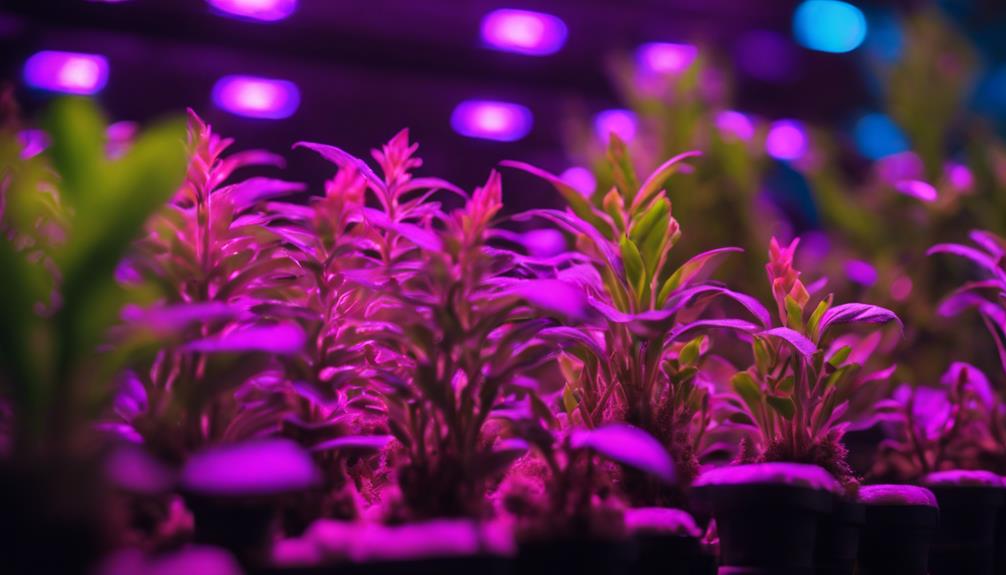
To maximize plant growth under LED lighting, it's crucial to adjust the light spectrum according to the plant's growth stage for best results. Here are some tips for using LED grow lights effectively:
- Measure and maintain proper light intensity (1000-1500 lux) to guarantee ideal plant health.
- Secure consistent photoperiods and provide periods of darkness for plants to mimic natural light conditions.
- Regularly clean LED lights and monitor temperature to create an ideal environment for plant growth.
- Experiment with different spectrums and settings to find the best combination for your specific plants.
Community Q&A

LED lighting's effectiveness in promoting plant growth has sparked various questions and discussions within the gardening community, leading to the initiation of a Community Q&A segment. Enthusiasts are curious about the specific benefits of using LED lights for plant growth, how these lights facilitate photosynthesis, and the ideal light intensity levels required for different types of plants.
Through this Q&A platform, experts shed light on the advantages of LED lights, emphasizing their ability to provide the necessary red and blue light spectrums essential for photosynthesis. Additionally, community members inquire about the energy efficiency of LED grow lights, their customization options, and suitability for various plant growth stages.
Participants seek guidance on how LED lights mimic natural sunlight, supporting healthy plant development from seedling to maturity. Scientists and plant biologists recommend LED lighting for indoor plant growth, contributing to the growing popularity and adoption of this technology in gardening circles.
Frequently Asked Questions
Can Plants Grow Under Normal LED Lights?
Plants can grow under normal LED lights, but LED grow lights are more beneficial with their red and blue light wavelengths. LED grow lights offer a wider range of colors and wattages, supporting plant growth effectively. They're suitable for all growth stages, from seedling to maturity, promoting healthy development.
Vegetables, flowers, and herbs respond well to LED lighting, yielding better results. Scientists recommend LED lighting for its energy efficiency, customizable spectrum, and cost-effectiveness.
Will Plants Grow Under White LED Lights?
White LED lights may not fully support plant growth due to their limited light spectrum. Plants require a range of light from violet to deep red for best development. Regular white LEDs emit light in a range that may not meet these specific needs.
To promote robust plant growth, specialized plant bulbs or LED grow lights with tailored spectrums are more effective options. For general lighting, white LEDs are useful, but for plants, tailored spectrums are more beneficial.
Can Plants Photosynthesize With LED Light?
Plants can effectively photosynthesize with LED light, given the right intensity and spectrum. LED grow lights provide ideal light spectrums, such as blue and red, essential for photosynthesis.
These lights mimic natural sunlight, enabling plants to convert light energy into chemical energy through photosynthesis. As long as the light intensity and spectrum meet the plants' specific requirements, they can thrive and develop efficiently under LED lighting.
Can Plants Burn Under LED Grow Lights?
Plants are unlikely to burn under LED grow lights due to their energy-efficient design and precise light distribution. LED lights emit minimal heat, reducing the risk compared to traditional options like HPS or HID.
Maintaining a proper distance of 6-12 inches between plants and LED grow lights helps prevent burning and guarantees ideal light absorption. The customizable light spectrums of LED lights allow for adjusting intensity and color to meet specific plant needs without causing burns.
Conclusion
To sum up, plants can indeed grow under LED lighting. These efficient and customizable lights provide the necessary spectrum for plant growth, mimicking natural sunlight.
With the right setup and care, plants can thrive under LED grow lights, producing healthy and vibrant foliage.
So, next time you're looking to cultivate a green oasis indoors, consider using LED grow lights for a flourishing garden that will brighten up any room like a ray of sunshine.
Lighting
Will Low Voltage Damage LED Lights: Managing Risks
Overlooking voltage risks can harm LED lights, but with the right precautions, you can ensure their longevity and performance.
Insufficient voltage management may harm LED lights, affecting their operation and lifespan. To prevent damage, it is crucial to take into account factors like voltage sensitivity, resistors, heat dissipation, and cable thickness. Thicker cables and strategic power supply placement can lower the risk of voltage drop and safeguard LED performance. Seeking professional guidance on LED selection and setup can further mitigate risks, ensuring peak brightness and longevity. By understanding these risks and implementing suitable precautions, one can safeguard their LED lighting investment effectively. More insights are available on managing LED risks effectively.
Key Takeaways
- Applying voltage below minimum forward level isn't harmful to LEDs.
- Thicker cables reduce voltage drop and protect LEDs.
- Strategic power supply points maintain consistent brightness.
- Voltage regulation devices enhance stability and performance.
- Seek expert advice to optimize LED performance and longevity.
Factors Affecting LED Light Damage
When managing the risks of low voltage on LED lights, understanding the factors that can lead to LED light damage is essential. LEDs are sensitive to voltage levels, and applying a voltage below the LED's minimum forward voltage typically doesn't harm the LED to a great extent. However, as LEDs heat up, they exhibit a negative temperature coefficient, allowing more current to flow through them, which can pose risks if not properly regulated. LEDs are often connected with resistors in series or current regulating circuits to ensure peak performance and prevent damage.
One critical factor affecting LED light damage is heat dissipation. Effective heat dissipation is vital for maintaining LED longevity and performance. Additionally, uneven current distribution, often caused by unmatched LEDs in a circuit, can lead to overheating and impact the overall performance of the LEDs. Understanding these risks and implementing proper current regulating circuits are essential steps in mitigating the potential damage that low voltage can pose to LED lights.
Calculating Cable Gauge and Length
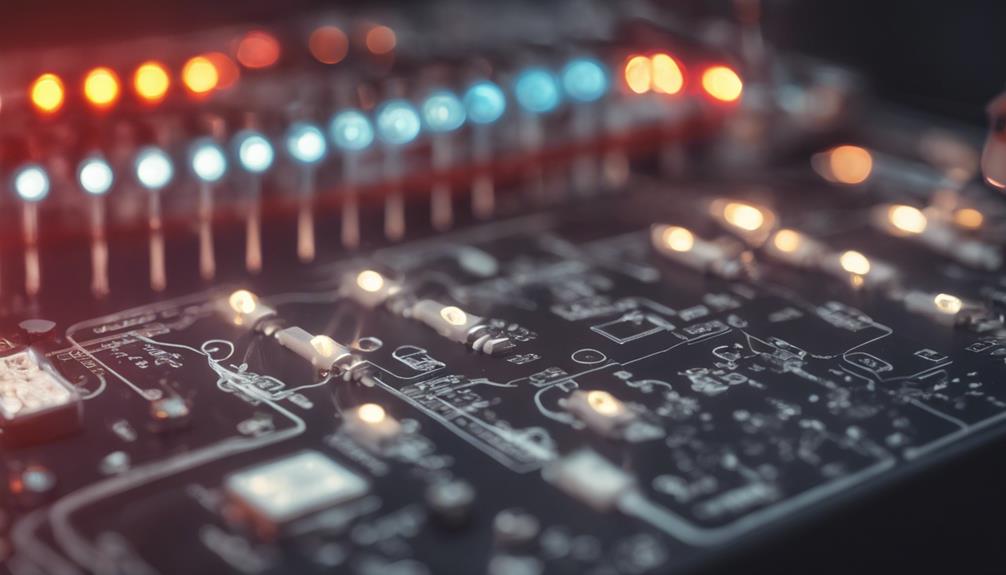
Calculating the cable gauge and length is essential in reducing voltage drop in LED lighting systems. Thicker cables are recommended for long installations with high-power LEDs to maintain voltage stability.
Strategic placement of power supply points can help counteract voltage drop over extended distances, ensuring peak LED performance.
Cable Gauge Importance
Thicker cables play an essential role in reducing voltage drop over extended distances in low voltage LED lighting systems. When considering the importance of cable gauge in LED installations, there are several key points to keep in mind:
- Calculating the correct cable gauge is important to prevent voltage drop in low voltage LED lighting systems.
- Thicker cables help minimize voltage drop over longer distances in LED setups.
- Proper cable length calculations based on voltage, current, and resistance are necessary for ensuring excellent performance.
Length Considerations
To address voltage drop challenges in low voltage LED lighting systems, considering the length of the cables is vital for optimizing power distribution. Longer cable lengths necessitate thicker gauges to minimize voltage drop and guarantee proper power distribution. Using thicker cables or adding more power supply points can help combat voltage drop issues in LED installations. It is important to accurately assess cable length and gauge requirements for efficient low voltage LED lighting setups. Seeking expert advice on calculating cable length can enhance the performance and longevity of low voltage LED systems.
| Cable Length (ft) | Recommended Cable Gauge | Voltage Drop (%) |
|---|---|---|
| 0-50 | 18 AWG | 2% |
| 51-100 | 16 AWG | 4% |
| 101-150 | 14 AWG | 6% |
| 151-200 | 12 AWG | 8% |
| 201-250 | 10 AWG | 10% |
Using Thicker Cables for Protection
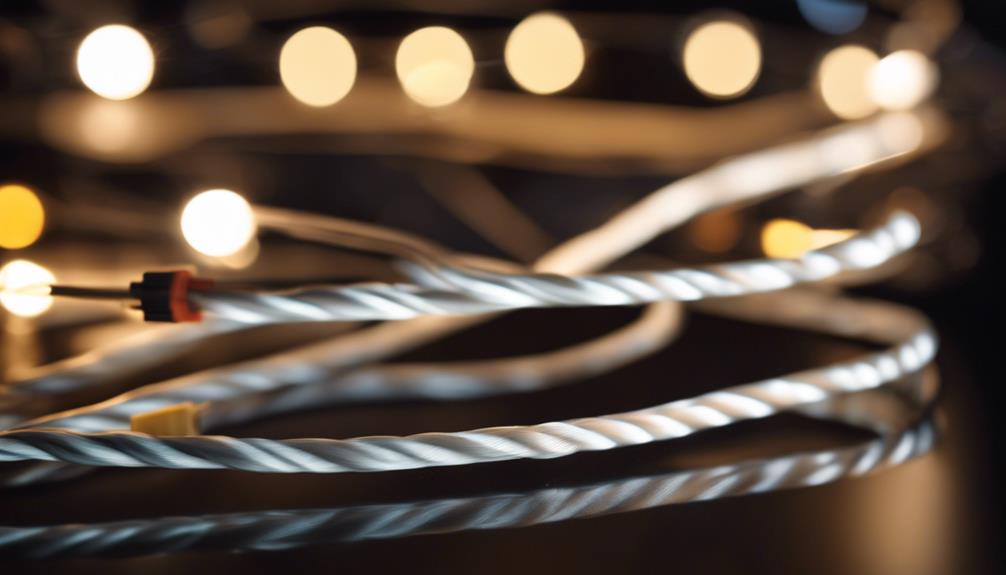
Selecting the appropriate cable gauge is essential in safeguarding low-voltage LED lights against potential damage and ensuring consistent performance. Thicker cables play a significant role in protecting low-voltage LED lighting systems. Here are key reasons why using thicker cables is beneficial:
- Thicker cables can reduce voltage drop in low-voltage LED lighting systems, maintaining steady power supply to the LEDs.
- Proper cable gauge selection helps prevent damage to LEDs, ensuring their longevity and efficiency.
- Thicker cables aid in protecting LEDs from potential overcurrent issues, contributing to stable LED performance.
Adding Extra Power Supply Points

Adding extra power supply points in low voltage LED lighting setups is essential for maintaining consistent brightness levels.
Strategically placing these additional points helps regulate the voltage to guarantee peak LED performance.
Calculating the ideal locations based on cable length and LED load is key to preventing dimming or flickering issues.
Power Supply Placement
Strategically placing extra power supply points along long low-voltage LED lighting installations can effectively minimize voltage drop and guarantee consistent illumination across all LEDs. Calculating the best placement of these power sources based on the total power output and cable length is essential. Proper distribution of power supplies prevents dimming or uneven lighting in low-voltage LED setups, safeguarding the brightness and performance of all LEDs are maintained.
- Calculate the best placement based on power output and cable length.
- Ensure proper distribution to prevent dimming or uneven lighting.
- Maintain brightness and performance of all LEDs in the system.
Voltage Regulation Devices
To enhance the stability and performance of low voltage LED lighting installations, incorporating voltage regulation devices at strategic points is essential. Adding extra power supply points along the LED strip helps manage voltage drop, ensuring consistent brightness and peak functionality.
These devices play a significant role in regulating voltage levels, particularly in longer LED strip runs, to prevent issues like dimming or uneven lighting. By carefully spacing and installing voltage regulation devices, you can maintain a steady voltage supply throughout the LED lighting system.
This strategic placement not only improves reliability but also extends the longevity of the installation, providing a more reliable and durable lighting solution for various applications.
Mitigating Risks With Expert Advice

Seeking expert advice from professionals can greatly reduce the risks associated with operating LED lights at low voltages. Professionals can provide valuable guidance on selecting the right LED lights suitable for low voltage applications. They can assist in understanding manufacturer specifications to guarantee the proper selection and usage of LEDs in low voltage scenarios. Expert advice also plays a vital role in optimizing LED performance and longevity under low voltage conditions. By consulting with professionals, individuals can avoid potential damage to LED lights and maximize their lifespan in such settings.
Professionals offer guidance on selecting suitable LED lights for low voltage applications.
Experts help in understanding manufacturer specifications for proper LED selection and usage.
Consulting with professionals optimizes LED performance and longevity in low voltage scenarios.
Longevity of LED Lighting System
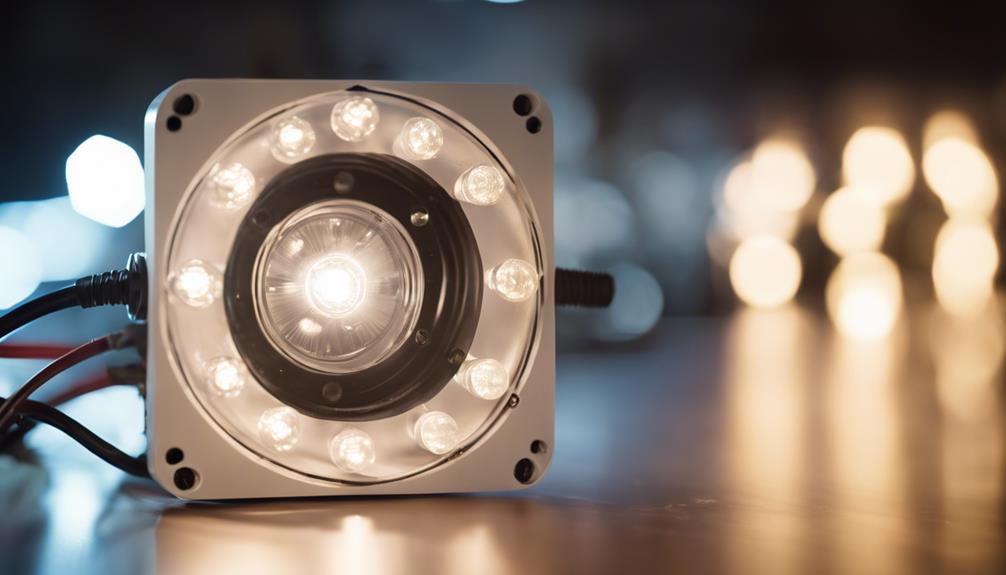
Professionals' guidance in selecting appropriate LED lights for low voltage applications can greatly enhance the longevity of the lighting system. LED lighting systems operating at lower voltage levels tend to experience extended lifespans as they generate less heat, contributing to increased efficiency.
Proper voltage management is key to optimizing the lifespan of LED lights. Choosing LEDs specifically designed for low voltage operation can further enhance the longevity of the lighting system. Consistent operation within the recommended voltage range is essential for maintaining the efficiency and durability of LED lighting systems.
Frequently Asked Questions
Can LED Lights Be Damaged by Low Voltage?
LED lights can be damaged by low voltage if the voltage falls below the manufacturer's specified range. However, operating LED lights at lower voltages within the essential safe range can actually increase their lifespan by reducing stress on the components.
It's vital to refer to the manufacturer's specifications to make sure that the LEDs aren't subjected to voltages that could cause damage. Dimmable LED lights offer flexibility and energy efficiency, even when operated at lower voltages.
What Is the Safe Voltage for LED Lights?
LED lights typically operate safely within a voltage range of 2 to 3.5 volts. Exceeding the maximum forward voltage, usually around 3.3 to 3.6 volts, can lead to LED damage.
To guarantee safe operation, constant current LED drivers regulate voltage effectively. Consulting manufacturer specifications for specific LED models is vital to determine the appropriate voltage range.
Proper voltage management is key to preventing overheating and premature LED failure.
Is 12V Too Much for LED Lights?
Operating LED lights at 12V is generally safe and within their specified limits. LED lights are designed to handle a range of voltages, including 12V, without damage. Properly regulated 12V power sources can provide excellent performance for LED lights.
In most cases, 12V isn't too much for LED lights, as it's a common voltage used for low-voltage LED lighting systems due to its compatibility and efficiency.
What Happens if You Undervolt a Led?
Undervolting an LED can result in dimmer light output, reduced brightness, flickering, and color accuracy issues. LEDs may not reach their full efficiency and performance potential when operated below their specified voltage range.
Premature failure and decreased lifespan are common outcomes of using low voltage with LEDs. It's important to adhere to the recommended voltage range to guarantee functionality and longevity of LED lights.
Conclusion
To sum up, safeguarding LED lights against low voltage damage requires careful consideration of cable gauge, length, and power supply points. By taking proactive measures such as using thicker cables and seeking expert advice, the longevity of the lighting system can be guaranteed.
Just as a sturdy ship navigates turbulent waters with a skilled captain at the helm, proper planning and maintenance are essential to steer clear of potential risks and illuminate the path ahead with brilliance.
-

 Vetted2 months ago
Vetted2 months ago14 Best Personalized Father's Day Gifts for Your Husband – Show Him You Care
-

 Alfresco1 month ago
Alfresco1 month agoAlfresco Stacker Doors: Seamless Indoor-Outdoor Living!
-

 Craft and Textiles3 months ago
Craft and Textiles3 months ago15 Best Places to Buy Appliances for Your Home – Top Retailers Reviewed
-

 Decorative Throws3 months ago
Decorative Throws3 months agoIs It Better to Dry Clean Blankets?
-

 Tableware and Dining Accessories3 months ago
Tableware and Dining Accessories3 months agoWhat Is the Meaning of the Word Tableware
-

 Tableware and Dining Accessories3 months ago
Tableware and Dining Accessories3 months agoWhat Is the Hindi Meaning of Tableware
-

 Craft and Textiles3 months ago
Craft and Textiles3 months ago15 Best Cordless Mowers for Effortless Lawn Care – Top Picks of 2024
-

 Craft and Textiles3 months ago
Craft and Textiles3 months ago15 Best Battery-Powered Leaf Blowers for Effortless Yard Work























